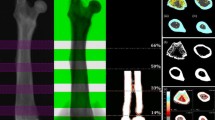Abstract.
Bone fragility in caged laying hens is a severe welfare problem, with fracture incidences in commercial flocks of up to 30% of all hens during their life. This fragility has been attributed to osteoporosis, the etiology of which is multifactorial in birds, as in humans, with genetic, environmental, and nutritional components. Greater understanding of the development of the disorder in hens could be obtained from the same kind of in vivo assessments available in human studies of osteoporosis. These high technology techniques for evaluation of bone mineral density (BMD), such as single or dual energy X-ray absorptiometry (SXA or DXA), quantitative computerized tomography (QCT), or attenuation by ultrasound (US), are so far not widely available to nonclinical researchers. We have modified an older X-ray film technique, radiographic absorptiometry (RA) by digitization of the analog video signal from a Philips BV-25 image intensifier, in single pulse fluoroscopy mode, and subsequent computer analysis with the public domain software package, NIH-Image 1.60. Compared with conventional RA, which uses standard X-ray film, our modified technique reduces X-ray exposure and allows the operator to digitize, store, and analyze many more images in a shorter time. We have called this modified technique ``digitized fluoroscopy'' (DF). In a longitudinal study of humeral radiographic density in a flock of 165 laying hens, significant relationships (P < 0.001) were observed between assessments made as early as 25 weeks, utilizing this DF technique in the humerus, and breaking strengths (and other postmortem indicators of osteoporosis) measured at 70 weeks. We conclude that DF can predict some eventual parameters of bone mass measured at 70 weeks from 25 to 40 weeks onward in bones from the same site in laying hens. The relationship between DF measurements made in the humerus and postmortem measurements of radiographic density and breaking strength made at another site (tibia) are less strong but still significant from 40 weeks onward.
Similar content being viewed by others
Author information
Authors and Affiliations
Additional information
Received: 20 May 1999 / Accepted: 9 March 2000
Rights and permissions
About this article
Cite this article
Fleming, R., McCormack, H. & Whitehead, C. Prediction of Breaking Strength in Osteoporotic Avian Bone Using Digitized Fluoroscopy, a Low Cost Radiographic Technique. Calcif Tissue Int 67, 309–313 (2000). https://doi.org/10.1007/s002230001120
Published:
Issue Date:
DOI: https://doi.org/10.1007/s002230001120




